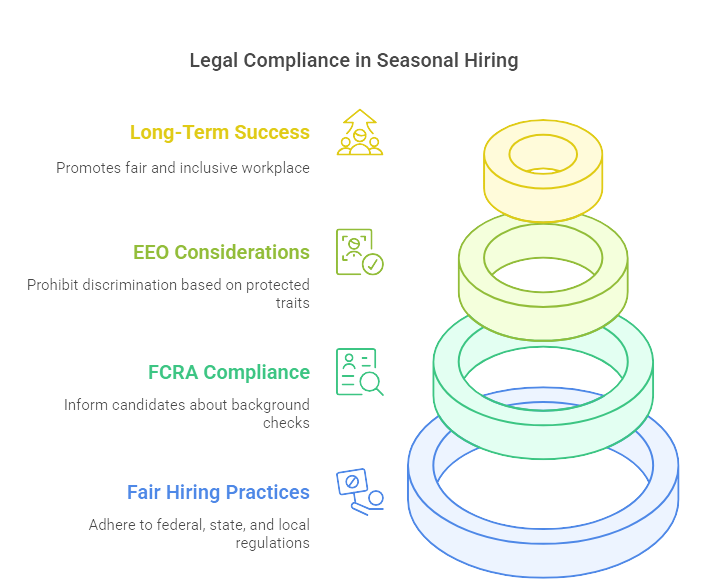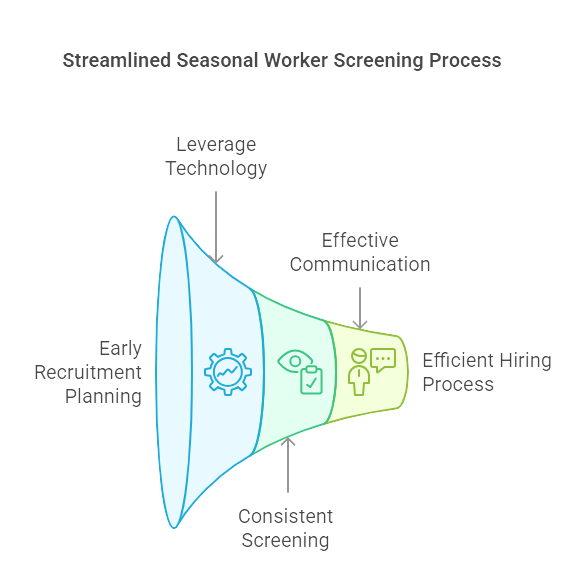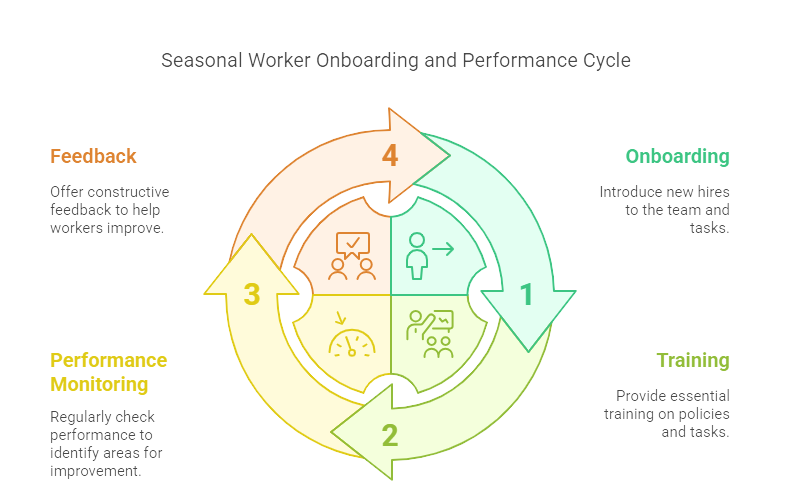Hiring seasonal workers can be a lifesaver for businesses. Whether it’s the bustling holiday season, the summer rush, or any peak period, having an effective process for screening seasonal workers is critical. Ensuring that you bring on reliable, competent, and trustworthy individuals not only supports business operations but also maintains a safe and positive work environment. This guide delves into best practices for seasonal worker screening, catering to business owners, HR professionals, recruiters, and job seekers across various industries.
Key Takeaways
- Seasonal employment is crucial for managing peak periods in industries like retail, hospitality, and agriculture.
- Effective screening ensures that reliable, skilled, and adaptable individuals are hired for seasonal roles.
- Key components of seasonal worker screening include background checks, employment verification, reference checks, drug and alcohol screening, and skills testing.
- Adhering to legal considerations, such as FCRA compliance and EEO guidelines, is essential for fair and transparent hiring.
- Early planning, leveraging technology, consistent processes, and effective communication enhance the seasonal hiring process, ensuring operational efficiency and a positive workplace environment.
Introduction
Seasonal employment isn't your typical 9-to-5 gig. It’s the kind of job that kicks into high gear at specific times of the year. Think about the extra hands needed in retail during the holiday shopping frenzy or the surge of lifeguards required at swimming pools when summer rolls around. Industries like hospitality, transportation, and even agriculture heavily rely on seasonal workers to manage their peak periods. Without these temporary troops, many businesses would simply crumble under the pressure.
So, why bother with stringent screening processes for workers who might only be around for a few months? Well, imagine bringing someone on board only to find out they’re unreliable or lack the necessary skills. That’s not just an inconvenience; it could harm your operations and bottom line. Proper screening ensures that you hire reliable, competent, and trustworthy individuals who can hit the ground running and keep your business humming smoothly. This guide will walk you through best practices for screening seasonal employees, setting you up for a stellar hiring season.

Understanding Seasonal Worker Screening
Definition and Scope
"Seasonal worker screening" refers to the assessment process designed to evaluate the suitability of individuals for temporary roles during peak periods. This screening encompasses a variety of checks and evaluations to ensure that candidates meet the company's standards for reliability, skill set, and cultural fit. Given the temporary nature of these roles, the screening process must be thorough yet efficient, striking a balance between rigor and speed.
Differences from Full-Time Employee Screening
Screening seasonal workers differs from full-time employee screening primarily in scope and depth. While both require assessing qualifications, seasonal screenings often focus more on immediate availability and basic competency rather than long-term potential and career progression. The turnaround time is shorter, and the process may be less extensive, prioritizing quick but effective verification of critical information like background checks and skill readiness. Additionally, seasonal screenings might weigh factors like flexibility and adaptability more heavily due to the varied and fast-paced nature of seasonal work.
Industries That Rely on Seasonal Workers
Several key industries depend heavily on seasonal workers to manage fluctuations in demand. Retail sees a significant boost during the holiday shopping season, requiring additional cashiers, stockers, and customer service representatives. In hospitality, the summer vacation period and holiday travel surge create a need for more hotel staff, event planners, and tour guides. Transportation sectors, such as shipping and delivery services, also spike during these periods, necessitating extra drivers and logistics personnel. Other fields like technology (for product launches), healthcare (for flu season), staffing agencies, tenant screening, and non-profits (for year-end fundraising campaigns) also lean on seasonal workers to meet their specific short-term demands.
Providing reliable and competent seasonal staff ensures that businesses in these industries can maintain a high level of service, capitalize on peak periods, and ultimately achieve their operational goals without compromise.
EXPERT INSIGHT: Seasonal hiring is never patching holes—it's maintaining the rhythm of your company at the times it needs you the most. Personally, I’ve seen the difference one solid seasonal employee can make to morale, to providing stellar service, to maybe even becoming an ultimate future regular rockstar. That kind of success only comes, however, with gradual, considerate screening. It is never about cramming the shift—it's about discovering people who care, even if it's only for the season. When we take the time to make it work, we don't merely make it through the holidays—we thrive there. - Charm Paz, CHRP
Key Components of Effective Seasonal Worker Screening
Background Checks
Conducting background checks is non-negotiable in the screening process. With seasonal employees coming in for a short stint, they must not bring in any baggage that could compromise the business. Focus on criminal history, verification of identity, and even credit checks if the role involves financial responsibility. The key types to consider include:
- Criminal Background Checks: Goes without saying, you don’t want someone with a checkered past involving theft or violence.
- Identity Verification: Dodges the bullet of potential fraud by ensuring the individual is who they claim to be.
- Credit Checks: Handy for positions involving financial transactions, such as cash handling or bookkeeping roles.
Employment Verification
Fast and efficient employment verification is your best friend when time is against you. Verify past jobs specifically for roles that need distinct skills or experiences. The trick here is to be laser-focused:
- Past Job Verification: Concentrate on positions related to the job they're applying for.
- Efficiency Tips: Use automated tools or third-party services to confirm employment history quickly. This is crucial when dealing with a high volume of applicants.
Reference Checks
Reference checks serve as your window to the applicant's past work habits and reliability. A quick chat with former supervisors can reveal a lot about a candidate's work ethic and dependability.
- Value of References: Confirming the integrity and reliability of a candidate can save a lot of headaches down the road.
- Effective Execution: Prepare a standard set of questions that target reliability, punctuality, and task-specific competencies.
Drug and Alcohol Screening
For jobs where safety is paramount, implementing drug and alcohol screening is non-negotiable. The last thing you need is an incident stemming from impaired judgment.
- Safety First: Positions involving machinery, driving, or any form of manual labor should definitely include this step.
- Screening Types: Standard urine tests or more specific screenings depending on your industry.
Skills and Competency Tests
To ensure the candidate can hit the ground running, skills and competency tests can be very telling. Tailor these tests to mirror the actual tasks the seasonal role will involve.
- Relevance is Key: Focus on tasks they'll perform daily. In retail, it might be a simple cash register operation test; in tech, perhaps a coding challenge.
- Quick Turnaround: Aim for tests that can be completed swiftly but still give a genuine insight into the candidate’s abilities.
By zeroing in on these key components, you streamline the process of identifying which applicants will seamlessly integrate into your business and make the busy season significantly easier to manage.
Legal Considerations and Compliance
Adhering to Fair Hiring Practices
Navigating the legal landscape of hiring seasonal workers can be tricky, but sticking to fair hiring practices is non-negotiable. To stay compliant, familiarize yourself with federal, state, and local regulations on employment. Scrutinize your hiring policies and make sure they align with anti-discrimination laws, such as those stipulated by the Equal Employment Opportunity Commission (EEOC). For more detailed guidance, the Department of Labor's hiring guidelines are a valuable resource.
FCRA Compliance
The Fair Credit Reporting Act (FCRA) plays a crucial role in background checks. It mandates that you inform candidates if they are being subjected to a background check and secure their consent beforehand. If any decision is influenced by the results, you're obligated to notify the candidate and provide them with a copy of the report. The Consumer Financial Protection Bureau offers extensive information on FCRA compliance, ensuring your actions are transparent and justifiable.
Equal Employment Opportunity (EEO) Considerations
When screening seasonal workers, impartiality is key. The EEOC prohibits discrimination based on race, color, religion, sex, national origin, age, disability, or genetic information. Implement training programs for your hiring teams to foster awareness and compliance with these non-discriminatory practices. Regularly audit your screening processes to eliminate bias and uphold a fair hiring standard.
Ensuring your seasonal worker screening process adheres to these legal standards not only protects your business from potential litigation but also promotes a fair and inclusive workplace, which is invaluable for long-term success.

Best Practices for Streamlined Seasonal Worker Screening
Early Planning and Recruitment
Starting your recruitment process early is like laying the groundwork for a solid structure. Think of it as the foundation that holds everything else together. Planning helps you avoid the chaos of last-minute hires. By creating a recruitment calendar, you can map out important dates and deadlines, giving you plenty of cushion for unexpected hiccups.
Leveraging Technology
In today’s digital age, not leveraging technology is like trying to paddle upstream without a paddle. Using HR software and automated screening tools can massively streamline your process, especially when you're handling a high volume of applications. Automating routine tasks like sending out application forms or initial screenings can save you a lot of time and energy, letting you focus on the tasks that require a human touch.
Consistent Screening Processes
Consistency is key. Developing a standard set of criteria for screening all seasonal workers helps eliminate bias and ensures you’re assessing everyone on the same basis. Training your hiring managers and HR staff to follow these processes religiously is crucial. It’s like giving everyone the same playbook; it ensures everyone is on the same page and knows exactly what’s expected.
Effective Communication
Clear and straightforward communication can make or break the candidate's experience. Keep candidates informed about where they stand in the screening process, what steps are coming up next, and any expectations. This transparency not only sets a positive tone but also reduces stress and uncertainty for the candidates. A positive candidate experience can enhance your brand’s reputation, making your business more attractive to future job seekers.
These best practices for streamlined seasonal worker screening will help you create an efficient, fair, and effective hiring process. Implementing these steps can ensure you bring on the best talent to meet your seasonal needs, keep your operations running smoothly, and maintain a vibrant work environment.

Preparing for High Volume Screening
Handling an influx of seasonal workers requires scalable solutions and a prepared internal team. Start by evaluating your current screening process and identifying bottlenecks. Can your background check provider handle higher volumes quickly? Are your employment verification and reference check methods efficient?
Scalable Solutions for High Volume
To efficiently manage high volumes, consider partnering with staffing agencies that specialize in seasonal hires. These agencies already have a pipeline of vetted candidates ready to go. Additionally, investing in HR software can automate portions of the screening process, from initial application sorting to background checks. This technology can significantly cut down on time and errors.
Another method is pre-screening candidates before peak hiring seasons. Create a candidate pool early, so you have ready-to-go profiles when the need arises. Scalable recruitment campaigns using targeted ads and social media can also pull in applicants quickly.
Training Internal Teams
Your HR team is the backbone of this operation, so they need to be well-prepared. Train them on efficient screening methods, and familiarize them with the additional tools and technologies at their disposal. Regular workshops and updated training materials can make a huge difference.
Providing resources like quick-reference guides or chat support can help your team manage their workload. Flexibility in roles and responsibilities within the team can also ensure that no single member feels overwhelmed. If needed, temporary HR staff can be brought in to assist with the peak periods.
By combining scalable solutions with a well-trained internal team, you'll be well-prepared to handle high volumes of seasonal workers seamlessly.
Post-Screening Tips
Onboarding Seasonal Workers
Once your screening process is complete, the next crucial step is onboarding the new hires. Seasonal workers often hit the ground running, so efficiency is key.
Quick Orientation and Training Sessions
Minimize downtime by designing concise orientation and training programs. Focus on the essentials: company policies, role-specific tasks, safety guidelines, and customer service expectations. Think of it as an express lane that still ensures quality.
- Initial Meet-and-Greet: A brief introduction to team members and a walkthrough of key areas.
- Job Training: Hands-on training sessions targeted at key responsibilities. Pairing new hires with experienced employees can accelerate this learning curve.
- Digital Resources: Utilize online training modules and videos that employees can access anytime for a quick refresher.
Performance Monitoring and Feedback
Regular performance checks are not just for full-time staff. With seasonal workers, monitoring and feedback become even more crucial.
Regular Monitoring of Performance
Tracking performance from day one lets you identify strengths and areas for improvement early on. It’s an ongoing process rather than a one-time evaluation.
- Spot Checks: Conduct random performance evaluations to maintain consistent quality.
- Daily Briefings: Quick daily meetings to discuss what went well and what needs attention.
Providing Feedback to Help Improvement
Constructive feedback is invaluable. It helps workers adjust and improve, ensuring they meet your expectations and potentially rehire in future seasons.
- Timely Feedback: Provide feedback immediately after observing performance issues or exemplary actions.
- Balanced Approach: Mix positive reinforcements with areas that need improvement. A balanced approach encourages motivation and growth.
- Open Communication: Create an environment where seasonal workers feel comfortable asking questions and seeking guidance.
By honing your onboarding and performance monitoring processes, you ensure that your seasonal workers are not just stop-gap measures but valuable team members who contribute effectively during peak times.

Conclusion
To recap, there are several essential elements for effectively screening seasonal workers. Start with thorough background checks to ensure safety and reliability. Follow this with employment verification to confirm past work experience and skills. Reference checks provide deeper insights into a candidate’s work ethic. For jobs requiring high safety standards, drug and alcohol screening is a must. Finally, testing specific skills and competencies ensures the worker is fit for the role.
Implementing these best practices can greatly enhance your seasonal hiring process. Plan early, leverage technology, maintain consistency, and communicate clearly with candidates. By following these guidelines, you not only streamline your operations but also create a positive work environment. Ultimately, a rigorous and well-executed screening process is key to business success and operational efficiency during peak periods.
Beyond process, remember that each seasonal employee is an individual joining your culture, if only briefly. How you interview, welcome, and treat them reverberates across your brand image and future candidate pools. Treat them kindly, and they can very likely be back next season—along with experience, devotion, and value added.

